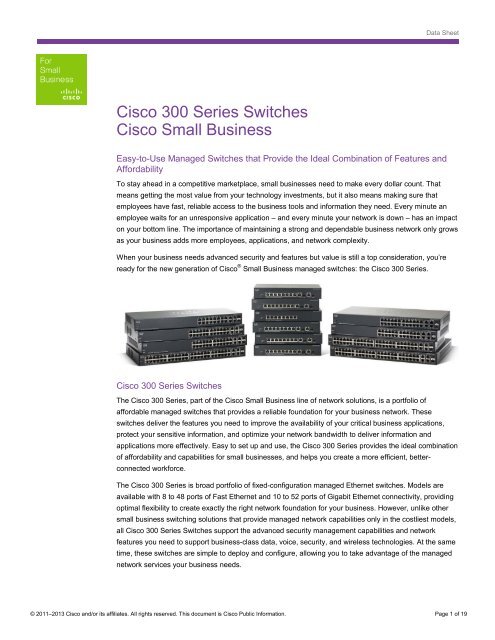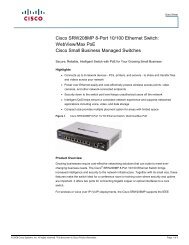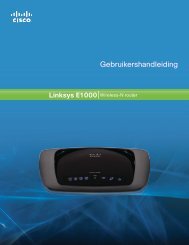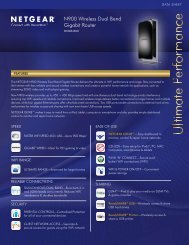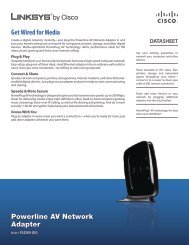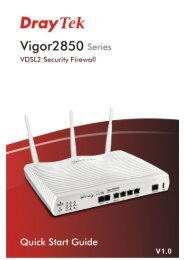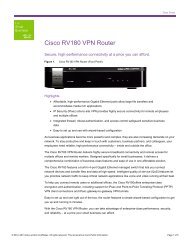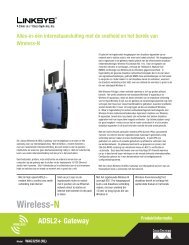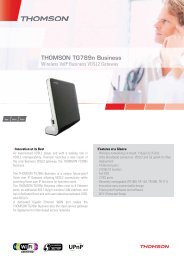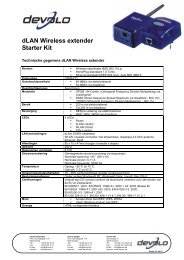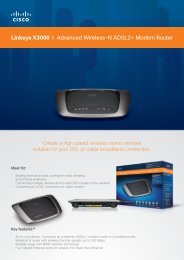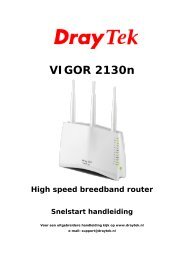Cisco WAP321 Wireless-N Selectable-Band Access Point with ...
Cisco WAP321 Wireless-N Selectable-Band Access Point with ...
Cisco WAP321 Wireless-N Selectable-Band Access Point with ...
Create successful ePaper yourself
Turn your PDF publications into a flip-book with our unique Google optimized e-Paper software.
Data Sheet<br />
<strong>Cisco</strong> 300 Series Switches<br />
<strong>Cisco</strong> Small Business<br />
Easy-to-Use Managed Switches that Provide the Ideal Combination of Features and<br />
Affordability<br />
To stay ahead in a competitive marketplace, small businesses need to make every dollar count. That<br />
means getting the most value from your technology investments, but it also means making sure that<br />
employees have fast, reliable access to the business tools and information they need. Every minute an<br />
employee waits for an unresponsive application – and every minute your network is down – has an impact<br />
on your bottom line. The importance of maintaining a strong and dependable business network only grows<br />
as your business adds more employees, applications, and network complexity.<br />
When your business needs advanced security and features but value is still a top consideration, you’re<br />
ready for the new generation of <strong>Cisco</strong> ® Small Business managed switches: the <strong>Cisco</strong> 300 Series.<br />
<strong>Cisco</strong> 300 Series Switches<br />
The <strong>Cisco</strong> 300 Series, part of the <strong>Cisco</strong> Small Business line of network solutions, is a portfolio of<br />
affordable managed switches that provides a reliable foundation for your business network. These<br />
switches deliver the features you need to improve the availability of your critical business applications,<br />
protect your sensitive information, and optimize your network bandwidth to deliver information and<br />
applications more effectively. Easy to set up and use, the <strong>Cisco</strong> 300 Series provides the ideal combination<br />
of affordability and capabilities for small businesses, and helps you create a more efficient, betterconnected<br />
workforce.<br />
The <strong>Cisco</strong> 300 Series is broad portfolio of fixed-configuration managed Ethernet switches. Models are<br />
available <strong>with</strong> 8 to 48 ports of Fast Ethernet and 10 to 52 ports of Gigabit Ethernet connectivity, providing<br />
optimal flexibility to create exactly the right network foundation for your business. However, unlike other<br />
small business switching solutions that provide managed network capabilities only in the costliest models,<br />
all <strong>Cisco</strong> 300 Series Switches support the advanced security management capabilities and network<br />
features you need to support business-class data, voice, security, and wireless technologies. At the same<br />
time, these switches are simple to deploy and configure, allowing you to take advantage of the managed<br />
network services your business needs.<br />
© 2011–2013 <strong>Cisco</strong> and/or its affiliates. All rights reserved. This document is <strong>Cisco</strong> Public Information. Page 1 of 19
Data Sheet<br />
Business Applications<br />
Whether you need a basic high-performance network to connect employee computers or a solution to<br />
deliver data, voice, and video services, the <strong>Cisco</strong> 300 Series offers a solution to meet your needs.<br />
Possible deployment scenarios include:<br />
● Secure desktop connectivity: <strong>Cisco</strong> 300 Series Switches can simply and securely connect<br />
employees working in small offices <strong>with</strong> each other and <strong>with</strong> all of the servers, printers, and other<br />
devices they use. High performance and reliable connectivity helps speed file transfers and data<br />
processing, improves network uptime, and keeps your employees connected and productive.<br />
● Secure <strong>Wireless</strong> connectivity: With its advanced Security features, Power over Ethernet, Auto<br />
Smartports, QoS, VLAN and <strong>Access</strong> Control features, the <strong>Cisco</strong> 300 Series Switches are the perfect<br />
foundation to add Business Grade wireless to an SMB network.<br />
● Unified communications: As a managed network solution, the <strong>Cisco</strong> 300 Series provides the<br />
performance and advanced traffic-handling intelligence you need to deliver all communications and<br />
data over a single network. <strong>Cisco</strong> offers a complete portfolio of IP telephony and other unified<br />
communications products designed for small businesses. <strong>Cisco</strong> 300 Series Switches have been<br />
rigorously tested to help ensure easy integration and full compatibility <strong>with</strong> these and other products,<br />
providing a complete small business solution.<br />
● Highly secure guest connectivity. <strong>Cisco</strong> 300 Series Switches let you extend highly secure network<br />
connectivity to guests in a variety of settings, such as a hotel, an office waiting room, or any other area<br />
open to nonemployee users. Using powerful but easy-to-configure security and traffic segmentation<br />
capabilities, you can isolate your vital business traffic from guest services and keep guests’ network<br />
sessions private from each other.<br />
Features and Benefits<br />
<strong>Cisco</strong> 300 Series Switches provide security, performance, traffic management, and other capabilities –<br />
optimized and customized, and at the right price for small businesses. The <strong>Cisco</strong> 300 Series provides:<br />
● High performance and reliability: <strong>Cisco</strong> 300 Series Switches have been rigorously tested to deliver<br />
the high availability and performance you expect from a <strong>Cisco</strong> switch. The solutions speed up file<br />
transfer times and improve slow, sluggish networks, while keeping your vital business applications<br />
available and preventing costly downtime. As a managed switching solution, the <strong>Cisco</strong> 300 Series also<br />
gives you the flexibility to manage and prioritize high-bandwidth traffic such as voice. That means you<br />
can empower your employees <strong>with</strong> state-of-the-art communication and productivity solutions, <strong>with</strong>out<br />
draining the performance of your other business applications.<br />
● Fast, easy setup and configuration: <strong>Cisco</strong> 300 Series Switches are designed to be easy to use and<br />
manage by small businesses and the partners who serve them. The included device manager software<br />
provides an intuitive, web-based interface to simplify setup, security, and quality of service (QoS) traffic<br />
prioritization, allowing even users <strong>with</strong>out IT expertise to configure the switch in minutes. <strong>Cisco</strong> also<br />
provides a <strong>Cisco</strong> FindIT Network Discovery Utility. This utility that works through a simple toolbar on the<br />
user’s web browser to discover <strong>Cisco</strong> devices in the network and display basic information, such as<br />
serial numbers and IP addresses, to aid in the configuration and deployment of <strong>Cisco</strong> Small Business<br />
products. For more information, and to download the utility, please visit www.cisco.com/go/findit. These<br />
switches use <strong>Cisco</strong> Discovery Protocol as well as Link Layer Discovery Protocol (LLDP-MED) to<br />
automatically detect all the devices connected to your network, and then automatically configure<br />
themselves for the appropriate connectivity and instructs the devices to use appropriate voice VLAN or<br />
© 2011–2013 <strong>Cisco</strong> and/or its affiliates. All rights reserved. This document is <strong>Cisco</strong> Public Information. Page 2 of 19
Data Sheet<br />
QoS parameters. For more advanced capabilities and hands-on control, the switches support<br />
Smartport roles which configure the ports <strong>with</strong> specific levels of Security, QoS, and availability<br />
according to the type of connected device, based on <strong>Cisco</strong> best practices and pretested configurations.<br />
The Auto Smartports feature applies the intelligence delivered through the Smartport roles and applies<br />
it automatically to the port based on the devices discovered over CDP or LLDP-MED. This facilitates<br />
zero touch deployments. Although the <strong>Cisco</strong> 300 Series is designed to be deployed <strong>with</strong>out using a<br />
command-line interface (CLI), <strong>Cisco</strong> Textview is available for those who prefer to use text-based<br />
configuration. Together, these features reduce the time your staff must devote to network deployment,<br />
management, and troubleshooting.<br />
● Strong security: The <strong>Cisco</strong> 300 Series Switches provide a high level of security and give you finegrained<br />
control to safeguard your network from unauthorized users. Advanced security features<br />
include:<br />
◦ Embedded security to protect management data traveling to and from the switch and encrypt<br />
network communications.<br />
◦ Extensive access control lists (ACLs) to restrict sensitive portions of the network from unauthorized<br />
users and guard against network attacks.<br />
◦ Guest virtual LANs (VLANs) to let you provide Internet connectivity to nonemployee users while<br />
isolating critical business services from guest traffic.<br />
◦ Support for advanced network security applications such as IEEE 802.1X port security to tightly limit<br />
access to specific segments of your network. Web based authentication provides a consistent<br />
interface to authenticate all types of host devices and operating systems, <strong>with</strong>out the complexity of<br />
deploying IEEE 802.1X clients on each endpoint.<br />
◦ Time based ACLs and Port Operation restrict access to the network during predesignated times,<br />
such as business hours.<br />
◦ Security mechanisms such as, Bridge Protocol Data Unit (BPDU) Guard and<br />
broadcast/multicast/unknown unicast storm control, protect the network from invalid configurations or<br />
malicious intent.<br />
◦ Secure Core Technology (SCT) helps ensure that the switch will receive and process management<br />
and protocol traffic no matter how much traffic is received.<br />
◦ Advanced defense mechanisms, including Dynamic ARP Inspection (DAI), IP Source Guard, and<br />
Dynamic Host Configuration Protocol (DHCP) snooping, detect and block deliberate network attacks.<br />
Combinations of these protocols are also referred to as IPMB (IP-MAC-port binding).<br />
◦ IPv6 First Hop Security extends the advanced threat protection to IPv6. This comprehensive security<br />
suite includes ND inspection, RA guard, DHCPv6 guard and neighbor binding integrity check,<br />
providing unparalleled protection against a vast range of address spoofing and man in the middle<br />
attack on IPv6 networks.<br />
◦ DOS (denial-of-service) attack prevention maximizes network uptime in the presence of an attack.<br />
◦ Protection of management sessions using Radius, TACACS+ and local database authentication as<br />
well as secure management sessions over SSL, SSH, and SNMPv3.<br />
© 2011–2013 <strong>Cisco</strong> and/or its affiliates. All rights reserved. This document is <strong>Cisco</strong> Public Information. Page 3 of 19
Data Sheet<br />
● Power over Ethernet: <strong>Cisco</strong> 300 Series Switches are available <strong>with</strong> up to 48 PoE ports of Fast<br />
Ethernet or Gigabit Ethernet connectivity. This capability simplifies advanced technology deployments<br />
such as IP telephony, wireless, and IP surveillance by allowing you to connect and power network<br />
endpoints over a single Ethernet cable. With no need to install separate power supplies for IP phones<br />
or wireless access points, you can take advantage of advanced communications technologies more<br />
quickly, and at a lower cost. Some models support both IEEE 802.3af PoE and IEEE 802.3at PoE+<br />
while others support IEEE 802.3af PoE only.<br />
● IP telephony support: <strong>Cisco</strong> 300 Series Switches include embedded QoS intelligence to prioritize<br />
delay-sensitive services such as voice and video, simplify unified communications deployments, and<br />
help ensure consistent network performance for all services. For example, automated voice VLAN<br />
capabilities let you plug any IP phone (including third-party phones) into your IP telephony network and<br />
receive an immediate dial tone. The switch automatically configures the device <strong>with</strong> the right VLAN and<br />
QoS parameters to prioritize voice traffic.<br />
● Networkwide Automatic Voice Deployment: Using a combination of CDP, LLDP-MED, Auto<br />
Smartports, and VSDP (Voice Services Discovery Protocol – a unique patent-pending <strong>Cisco</strong> protocol),<br />
customers can deploy an end-to-end voice network dynamically. The switches in the network<br />
automatically converge around a single voice VLAN and QoS parameters and then propagate them out<br />
to the phones on the ports where they are discovered. For example, automated voice VLAN capabilities<br />
let you plug any IP phone (including third-party phones) into your IP telephony network and receive an<br />
immediate dial tone. The switch automatically configures the device <strong>with</strong> the right VLAN and QoS<br />
parameters to prioritize voice traffic.<br />
● Advanced network management capabilities: As managed switches, the <strong>Cisco</strong> 300 Series lets you<br />
use a variety of advanced features to control traffic over your network. Features include:<br />
◦ Static routing/Layer 3 switching between VLANs: This capability allows you to segment your network<br />
into separate workgroups and communicate across VLANs <strong>with</strong>out degrading application<br />
performance. As a result, you can manage internal routing <strong>with</strong> your switches and dedicate your<br />
router to external traffic and security, helping your network run more efficiently.<br />
◦ IPv6 support: As the IP network addressing scheme evolves to accommodate more devices, you<br />
can make sure that your network is ready. The <strong>Cisco</strong> 300 Series provides native support for IPv6,<br />
the newest version of the Internet Protocol, as well as the previous IPv4 standard. As a result, you<br />
will be able to move up to the next generation of networking applications and operating systems<br />
<strong>with</strong>out an extensive equipment upgrade.<br />
◦ Dual image support: With the ability to maintain dual images of your switches, you can perform<br />
software upgrades <strong>with</strong>out having to take the network offline and <strong>with</strong>out worrying about an outage<br />
during an upgrade.<br />
◦ Dual Configuration files support: Allows configuring the device, validating that it is configured<br />
correctly and then saving this configuration to become effective after reboot. Additionally, a mirror<br />
configuration file, providing automatic back-up of the latest stable configuration file maximizes<br />
network uptime.<br />
◦ Remote management: Using Simple Network Management Protocol (SNMP), you can set up and<br />
manage all switches and other <strong>Cisco</strong> devices in your network remotely, instead of having to directly<br />
connect to them.<br />
◦ Additional management options: The switches can be fully managed using the Web GUI or using a<br />
full command-line interface (CLI).<br />
© 2011–2013 <strong>Cisco</strong> and/or its affiliates. All rights reserved. This document is <strong>Cisco</strong> Public Information. Page 4 of 19
Data Sheet<br />
● Optimal energy efficiency: <strong>Cisco</strong> 300 Series Switches are designed <strong>with</strong> a variety of power-saving<br />
features across all models, providing the industry’s broadest portfolio of “green” switches. These<br />
switches optimize power use to protect the environment and reduce energy costs, <strong>with</strong>out<br />
compromising performance. Power-saving features include:<br />
◦ The latest application-specific integrated circuits (ASICs), using low-power 65-nanometer technology<br />
(these chipsets allow for lower power consumption and thinner, more efficient designs).<br />
◦ Support for the Energy Efficient Ethernet (IEEE 802.3az) standard, which reduces energy<br />
consumption by monitoring the amount of traffic on an active link and putting the link into a sleep<br />
state during quiet periods.<br />
◦ Automatic power shutoff on ports when a link is down.<br />
◦ Embedded intelligence to adjust signal strength based on cable length.<br />
◦ Fanless design in most models, which reduces power consumption, increases reliability, and<br />
provides quieter operation.<br />
◦ LEDs can be turned off to conserve power.<br />
● Expansion ports: The <strong>Cisco</strong> 300 Series provides more ports per Gigabit Ethernet switch than<br />
traditional switch models, giving you more flexibility to connect and empower your business. Gigabit<br />
Ethernet models feature 28- and 52-port switches, versus traditional devices that offer 20 or 44 ports<br />
<strong>with</strong> four shared ports giving you more value. The <strong>Cisco</strong> 300 Series also offers mini gigabit interface<br />
converter (mini-GBIC) expansion slots that give you the option to add fiber-optic or Gigabit Ethernet<br />
uplink connectivity to the switch. With the ability to increase the connectivity range of the switches, you<br />
have more flexibility to design your network around your unique business environment, and to easily<br />
connect switches on different floors or across the business.<br />
● Multiple languages: The <strong>Cisco</strong> 300 Series is available in seven languages: English, French, German,<br />
Italian, Spanish, Japanese, and simplified Chinese. All product user interfaces and documentation are<br />
translated, giving you the ability to select your preferred language.<br />
● Peace of mind and investment protection: <strong>Cisco</strong> 300 Series Switches offer the reliable performance,<br />
investment protection, and peace of mind you expect from a <strong>Cisco</strong> switch. When you invest in the<br />
<strong>Cisco</strong> 300 Series, you gain the benefit of:<br />
◦ <strong>Cisco</strong> limited lifetime warranty <strong>with</strong> next business day advance replacement (where available).<br />
◦ Rigorous testing to help ensure easy integration and compatibility <strong>with</strong> other <strong>Cisco</strong> networking and<br />
communications products, including the complete <strong>Cisco</strong> Small Business portfolio.<br />
● Service and Support: <strong>Cisco</strong> 300 Series Switches are backed by the <strong>Cisco</strong> Small Business Support<br />
Service, which provides affordable peace-of-mind coverage. This subscription-based service helps you<br />
protect your investment and derive maximum value from <strong>Cisco</strong> Small Business products. Delivered by<br />
<strong>Cisco</strong> and backed by your trusted partner, this comprehensive service includes software updates,<br />
access to the <strong>Cisco</strong> Small Business Support Center, and extends technical service to three years.<br />
<strong>Cisco</strong> Small Business products are supported by professionals in <strong>Cisco</strong> Small Business Support Center<br />
locations worldwide who are specifically trained to understand your needs. The <strong>Cisco</strong> Small Business<br />
Support Community, an online forum, enables you to collaborate <strong>with</strong> your peers and reach <strong>Cisco</strong><br />
technical experts for support information.<br />
© 2011–2013 <strong>Cisco</strong> and/or its affiliates. All rights reserved. This document is <strong>Cisco</strong> Public Information. Page 5 of 19
Data Sheet<br />
● <strong>Cisco</strong> Limited Lifetime Hardware Warranty: <strong>Cisco</strong> 300 Series Switches offer a limited lifetime<br />
hardware warranty <strong>with</strong> next business day advance replacement (where available, otherwise same day<br />
ship) and a limited lifetime warranty for fans and power supplies. In addition, <strong>Cisco</strong> offers software<br />
application updates for bug fixes for the warranty term, and telephone technical support at no charge<br />
for the first 12 months following the date of purchase. To download software updates, go to:<br />
www.cisco.com/cisco/web/download/index.html.<br />
Product warranty terms and other information applicable to <strong>Cisco</strong> products are available at<br />
www.cisco.com/go/warranty.<br />
Product Specifications<br />
Table 1 gives the product specifications for the <strong>Cisco</strong> 300 Series Switches.<br />
Table 1.<br />
Product Specifications<br />
Feature<br />
Performance<br />
Switching capacity and<br />
forwarding rate<br />
All switches are wire-speed and<br />
non-blocking<br />
Description<br />
Model Name<br />
Capacity in Millions of Packets<br />
per Second (mpps) (64-byte<br />
packets)<br />
SF300-08 1.19 1.6<br />
SF302-08 4.17 5.6<br />
SF302-08P 4.17 5.6<br />
SF302-08PP 4.17 5.6<br />
SF302-08MP 4.17 5.6<br />
SF302-08MPP 4.17 5.6<br />
SF300-24 9.52 12.8<br />
SF300-24P 9.52 12.8<br />
SF300-24PP 9.52 12.8<br />
SF300-24MP 9.52 12.8<br />
SF300-48 13.10 17.6<br />
SF300-48P 13.10 17.6<br />
SF300-48PP 13.10 17.6<br />
SG300-10 14.88 20.0<br />
SG300-10SFP 14.88 20.0<br />
SG300-10P 14.88 20.0<br />
SG300-10PP 14.88 20.0<br />
SG300-10MP 14.88 20.0<br />
SG300-10MPP 14.88 20.0<br />
SG300-20 29.76 40.0<br />
SG300-28 41.67 56.0<br />
SG300-28P 41.67 56.0<br />
SG300-28PP 41.67 56.0<br />
SG300-28MP 41.67 56.0<br />
SG300-52 77.38 104.0<br />
SG300-52P 77.38 104.0<br />
SG300-52MP 77.38 104.0<br />
Switching Capacity in<br />
Gigabits per Second (Gbps)<br />
© 2011–2013 <strong>Cisco</strong> and/or its affiliates. All rights reserved. This document is <strong>Cisco</strong> Public Information. Page 6 of 19
Data Sheet<br />
Feature<br />
Description<br />
Layer 2 Switching<br />
Spanning Tree Protocol (STP)<br />
Port grouping<br />
VLAN<br />
Voice VLAN<br />
Multicast TV VLAN<br />
Q-in-Q VLAN<br />
Generic VLAN Registration<br />
Protocol (GVRP)/Generic<br />
Attribute Registration Protocol<br />
(GARP)<br />
Unidirectional Link Detection<br />
(UDLD)<br />
Dynamic Host Configuration<br />
Protocol (DHCP) Relay at Layer 2<br />
Internet Group Management<br />
Protocol (IGMP) versions 1, 2,<br />
and 3 snooping<br />
IGMP Querier<br />
Head-of-line (HOL) blocking<br />
Jumbo Frames<br />
Standard 802.1d Spanning Tree support<br />
Fast convergence using 802.1w (Rapid Spanning Tree [RSTP]), enabled by default<br />
8 instances are supported<br />
Multiple Spanning Tree instances using 802.1s (MSTP)<br />
Support for IEEE 802.3ad Link Aggregation Control Protocol (LACP)<br />
● Up to 8 groups<br />
● Up to 8 ports per group <strong>with</strong> 16 candidate ports for each (dynamic) 802.3ad link aggregation<br />
Support for up to 4096 VLANs simultaneously Port-based and 802.1Q tag-based VLANs MACbased<br />
VLAN<br />
Management VLAN<br />
Private VLAN Edge (PVE), also known as protected ports, <strong>with</strong> multiple uplinks<br />
Guest VLAN Unauthenticated VLAN<br />
Dynamic VLAN assignment via Radius server along <strong>with</strong> 802.1x client authentication<br />
CPE VLAN<br />
Voice traffic is automatically assigned to a voice-specific VLAN and treated <strong>with</strong> appropriate levels<br />
of QoS.<br />
Auto voice capabilities deliver network-wide zero touch deployment of voice endpoints and call<br />
control devices.<br />
Multicast TV VLAN allows the single multicast VLAN to be shared in the network while subscribers<br />
remain in separate VLANs (Also known as MVR)<br />
VLANs transparently cross a service provider network while isolating traffic among customers<br />
Protocols for automatically propagating and configuring VLANs in a bridged domain<br />
UDLD monitors physical connection to detect unidirectional links caused by incorrect wiring or<br />
cable/port faults to prevent forwarding loops and blackholing of traffic in switched networks<br />
Relay of DHCP traffic to DHCP server in different VLAN. Works <strong>with</strong> DHCP Option 82<br />
IGMP limits bandwidth-intensive multicast traffic to only the requesters; supports 1K multicast<br />
groups (source-specific multicasting is also supported)<br />
IGMP querier is used to support a Layer 2 multicast domain of snooping switches in the absence of<br />
a multicast router<br />
HOL blocking prevention<br />
Up to 9K (9216) bytes<br />
Layer 3<br />
IPv4 routing<br />
Classless Inter-Domain Routing<br />
(CIDR)<br />
Layer 3 Interface<br />
DHCP relay at Layer 3<br />
User Datagram Protocol (UDP)<br />
relay<br />
DHCP Server<br />
Wirespeed routing of IPv4 packets<br />
Up to 512 static routes and up to 128 IP interfaces<br />
Support for CIDR<br />
Configuration of layer 3 interface on physical port, LAG, VLAN interface or Loopback interface<br />
Relay of DHCP traffic across IP domains<br />
Relay of broadcast information across Layer 3 domains for application discovery or relaying of<br />
BootP/DHCP packets<br />
Switch functions as an IPv4 DHCP Server serving IP addresses for multiple DHCP pools/scopes<br />
Support for DHCP options<br />
Security<br />
Secure Shell (SSH) Protocol<br />
Secure Sockets Layer (SSL)<br />
SSH is a secure replacement for Telnet traffic. SCP also uses SSH. SSH v1 and v2 are supported<br />
SSL support: Encrypts all HTTPS traffic, allowing highly secure access to the browser-based<br />
management GUI in the switch<br />
IEEE 802.1X (Authenticator role) 802.1X: RADIUS authentication and accounting, MD5 hash; guest VLAN; unauthenticated VLAN,<br />
single/multiple host mode and single/multiple sessions<br />
Supports time-based 802.1X Dynamic VLAN assignment<br />
© 2011–2013 <strong>Cisco</strong> and/or its affiliates. All rights reserved. This document is <strong>Cisco</strong> Public Information. Page 7 of 19
Data Sheet<br />
Feature<br />
Web Based Authentication<br />
STP Bridge Protocol Data Unit<br />
(BPDU) Guard<br />
STP Root Guard<br />
DHCP snooping<br />
IP Source Guard (IPSG)<br />
Dynamic ARP Inspection (DAI)<br />
IP/Mac/Port Binding (IPMB)<br />
Secure Core Technology (SCT)<br />
Secure Sensitive Data (SSD)<br />
Layer 2 isolation Private VLAN<br />
Edge (PVE) <strong>with</strong> community<br />
VLAN<br />
Port security<br />
RADIUS/TACACS+<br />
Storm control<br />
RADIUS accounting<br />
DoS prevention<br />
ACLs<br />
Quality of Service<br />
Priority levels<br />
Scheduling<br />
Class of service<br />
Rate limiting<br />
Congestion avoidance<br />
Standards<br />
Standards<br />
Description<br />
Web based authentication provides network admission control through web browser to any host<br />
devices and operating systems.<br />
A security mechanism to protect the network from invalid configurations. A port enabled for BPDU<br />
Guard is shut down if a BPDU message is received on that port.<br />
This prevents edge devices not in the network administrator’s control from becoming Spanning<br />
Tree Protocol root nodes.<br />
Filters out DHCP messages <strong>with</strong> unregistered IP addresses and/or from unexpected or untrusted<br />
interfaces. This prevents rogue devices from behaving as a DHCP Server.<br />
When IP Source Guard is enabled at a port, the switch filters out IP packets received from the port<br />
if the source IP addresses of the packets have not been statically configured or dynamically learned<br />
from DHCP snooping. This prevents IP Address Spoofing.<br />
The switch discards ARP packets from a port if there is no static or dynamic IP/MAC bindings or if<br />
there is a discrepancy between the source or destination address in the ARP packet. This prevents<br />
man-in-the-middle attacks.<br />
The features (DHCP Snooping, IP Source Guard, and Dynamic ARP Inspection) above work<br />
together to prevent DOS attacks in the network, thereby increasing network availability.<br />
Ensures that the switch will receive and process management and protocol traffic no matter how<br />
much traffic is received.<br />
A mechanism to manage sensitive data (such as passwords, keys, etc) securely on the switch,<br />
populating this data to other devices, and secure autoconfig. <strong>Access</strong> to view the sensitive data as<br />
plaintext or encrypted is provided according to the user configured access level and the access<br />
method of the user.<br />
PVE (also known as protected ports) provides Layer 2 isolation between devices in the same<br />
VLAN, supports multiple uplinks.<br />
The ability to lock Source MAC addresses to ports, and limits the number of learned MAC<br />
addresses.<br />
Supports RADIUS and TACACS authentication. Switch functions as a client.<br />
Broadcast, multicast, and unknown unicast<br />
The RADIUS accounting functions allow data to be sent at the start and end of services, indicating<br />
the amount of resources (such as time, packets, bytes, and so on) used during the session.<br />
Denial-of-Service (DOS) attack prevention<br />
Support for up to 512 rules<br />
Drop or rate limit based on source and destination MAC, VLAN ID or IP address, protocol, port,<br />
differentiated services code point (DSCP)/IP precedence, TCP/ UDP source and destination ports,<br />
802.1p priority, Ethernet type, Internet Control Message Protocol (ICMP) packets, IGMP packets,<br />
TCP flag, Time-based ACLs supported.<br />
4 hardware queues<br />
Strict priority and weighted round-robin (WRR)<br />
Queue assignment based on DSCP and class of service (802.1p/CoS)<br />
Port based; 802.1p VLAN priority based; IPv4/v6 IP precedence/type of service (ToS)/DSCP based;<br />
Differentiated Services (DiffServ); classification and re-marking ACLs, trusted QoS.<br />
Ingress policer; egress shaping and rate control; per VLAN, per port, and flow based.<br />
A TCP congestion avoidance algorithm is required to minimize and prevent global TCP loss<br />
synchronization.<br />
IEEE 802.3 10BASE-T Ethernet, IEEE 802.3u 100BASE-TX Fast Ethernet, IEEE 802.3ab<br />
1000BASE-T Gigabit Ethernet, IEEE 802.3ad LACP, IEEE 802.3z Gigabit Ethernet, IEEE 802.3x<br />
Flow Control, IEEE 802.1D (STP, GARP, and GVRP),IEEE 802.1Q/p VLAN, IEEE 802.1w RSTP,<br />
IEEE 802.1s Multiple STP, IEEE 802.1X Port <strong>Access</strong> Authentication, IEEE 802.3af, IEEE 802.3at,<br />
RFC 768, RFC 783, RFC 791, RFC 792, RFC 793, RFC 813, RFC 879, RFC 896, RFC 826, RFC<br />
854, RFC 855, RFC 856, RFC 858, RFC 894, RFC 919, RFC 922, RFC 920, RFC 950, RFC 1042,<br />
RFC 1071, RFC 1123, RFC 1141, RFC 1155, RFC 1157, RFC 1350, RFC 1533, RFC 1541, RFC<br />
1624, RFC 1700, RFC 1867, RFC 2030, RFC 2616, RFC 2131, RFC 2132, RFC 3164, RFC 3411,<br />
RFC 3412, RFC 3413, RFC 3414, RFC 3415, RFC 2576, RFC 4330, RFC 1213, RFC 1215, RFC<br />
1286, RFC 1442, RFC 1451, RFC 1493, RFC 1573, RFC 1643, RFC 1757, RFC 1907, RFC 2011,<br />
RFC 2012, RFC 2013, RFC 2233, RFC 2618, RFC 2665, RFC 2666, RFC 2674, RFC 2737, RFC<br />
2819, RFC 2863, RFC 1157, RFC 1493, RFC 1215, RFC 3416<br />
© 2011–2013 <strong>Cisco</strong> and/or its affiliates. All rights reserved. This document is <strong>Cisco</strong> Public Information. Page 8 of 19
Data Sheet<br />
Feature<br />
IPv6<br />
IPv6<br />
IPv6 QoS<br />
IPv6 ACL<br />
IPv6 First Hop Security<br />
Multicast Listener Discovery<br />
(MLD v1/2) snooping<br />
IPv6 applications<br />
Description<br />
IPv6 host mode<br />
IPv6 over Ethernet Dual IPv6/IPv4 stack<br />
IPv6 neighbor and router discovery (ND) IPv6 stateless address auto-configuration<br />
Path maximum transmission unit (MTU) discovery<br />
Duplicate address detection (DAD) ICMP version 6<br />
IPv6 over IPv4 network <strong>with</strong> Intra-Site Automatic Tunnel Addressing Protocol (ISATAP) support<br />
USGv6 and IPv6 Gold Logo certified<br />
Prioritize IPv6 packets in hardware<br />
Drop or rate limit IPv6 packets in hardware<br />
RA guard<br />
ND inspection<br />
DHCPv6 guard<br />
Neighbor binding table (Snooping and static entries)<br />
Neighbor binding integrity check<br />
Deliver IPv6 multicast packets only to the required receivers<br />
Web/SSL, Telnet server/SSH, ping, traceroute, Simple Network Time Protocol (SNTP), Trivial File<br />
Transfer Protocol (TFTP), SNMP, RADIUS, syslog, DNS client, Telnet Client, DHCP Client, DHCP<br />
Autoconfig, IPv6 DHCP Relay, TACACS<br />
IPv6 RFCs supported RFC 4443 (which obsoletes RFC2463) – ICMP version 6<br />
Management<br />
Web user interface<br />
SNMP<br />
Standard MIBs<br />
RFC 4291 (which obsoletes RFC 3513) – IPv6 address architecture<br />
RFC 4291 – IPv6 addressing architecture<br />
RFC 2460 – IPv6 specification<br />
RFC 4861 (which obsoletes RFC 2461) – Neighbor discovery for IPv6<br />
RFC 4862 (which obsoletes RFC 2462) – IPv6 stateless address auto-configuration<br />
RFC 1981 – Path MTU discovery<br />
RFC 4007 – IPv6 scoped address architecture<br />
RFC 3484 – Default address selection mechanism<br />
RFC 5214 (which obsoletes RFC 4214) – ISATAP tunneling RFC 4293 – MIB IPv6: Textual<br />
conventions and general group RFC 3595 – Textual conventions for IPv6 flow label<br />
Built-in switch configuration utility for easy browser-based device configuration (HTTP/HTTPS).<br />
Supports configuration, system dashboard, system maintenance, and monitoring.<br />
SNMP versions 1, 2c, and 3 <strong>with</strong> support for traps, and SNMP version 3 user-based security model<br />
(USM)<br />
draft-ietf-bridge-8021x-MIB<br />
draft-ietf-bridge-rstpmib-04-MIB<br />
draft-ietf-hubmib-etherif-MIB-v3-00-MIB<br />
draft-ietf-syslog-device-MIB<br />
ianaaddrfamnumbers-MIB<br />
ianaifty-MIB<br />
ianaprot-MIB<br />
inet-address-MIB<br />
ip-forward-MIB<br />
ip-MIB<br />
RFC1155-SMI<br />
RFC1213-MIB<br />
rfc2012-MIB<br />
rfc2011-MIB<br />
draft-ietf-entmib-sensor-MIB<br />
lldp-MIB lldpextdot1-MIB<br />
lldpextdot3-MIB<br />
lldpextmed-MIB p-bridge-MIB<br />
q-bridge-MIB<br />
rfc1389-MIB<br />
rfc1493-MIB<br />
rfc1611-MIB<br />
rfc1612-MIB<br />
rfc1850-MIB<br />
© 2011–2013 <strong>Cisco</strong> and/or its affiliates. All rights reserved. This document is <strong>Cisco</strong> Public Information. Page 9 of 19
Data Sheet<br />
Feature<br />
Standard MIBs (continued)<br />
Private MIBs<br />
Description<br />
SNMPv2-MIB<br />
SNMPv2-SMI<br />
SNMPv2-TM<br />
RMON-MIB.my<br />
dcb-raj-DCBX-MIB-1108-MIB<br />
rfc1724-MIB<br />
RFC-1212.my_for_MG-Soft<br />
rfc1213-MIB<br />
rfc1757-MIB<br />
RFC-1215.my<br />
SNMPv2-CONF.my<br />
SNMPv2-TC.my<br />
rfc2674-MIB<br />
rfc2575-MIB<br />
rfc2573-MIB<br />
rfc2233-MIB<br />
rfc2013-MIB<br />
CISCOSB-lldp-MIB<br />
CISCOSB-brgmulticast-MIB<br />
CISCOSB-bridgemibobjects-MIB<br />
CISCOSB-bonjour-MIB<br />
CISCOSB-dhcpcl-MIB<br />
CISCOSB-MIB<br />
CISCOSB-wrandomtaildrop-MIB<br />
CISCOSB-traceroute-MIB<br />
CISCOSB-telnet-MIB<br />
CISCOSB-stormctrl-MIB<br />
CISCOSB-ssh-MIB<br />
CISCOSB-socket-MIB<br />
CISCOSB-sntp-MIB<br />
CISCOSB-smon-MIB<br />
CISCOSB-phy-MIB<br />
CISCOSB-multisessionterminal-MIB<br />
CISCOSB-mri-MIB<br />
CISCOSB-jumboframes-MIB<br />
CISCOSB-gvrp-MIB<br />
CISCOSB-endofmib-MIB<br />
CISCOSB-dot1x-MIB<br />
CISCOSB-deviceparams-MIB<br />
CISCOSB-cli-MIB<br />
CISCOSB-cdb-MIB<br />
CISCOSB-brgmacswitch-MIB<br />
CISCOSB-3sw2swtables-MIB<br />
CISCOSB-smartPorts-MIB<br />
CISCOSB-tbi-MIB<br />
CISCOSB-macbaseprio-MIB<br />
CISCOSB-policy-MIB<br />
CISCOSB-env_mib<br />
CISCOSB-sensor-MIB<br />
CISCOSB-aaa-MIB<br />
CISCOSB-application-MIB<br />
CISCOSB-bridgesecurity-MIB<br />
CISCOSB-copy-MIB<br />
CISCOSB-CpuCounters-MIB<br />
CISCOSB-Custom1BonjourService-MIB<br />
rfc1907-MIB<br />
rfc2571-MIB<br />
rfc2572-MIB<br />
rfc2574-MIB<br />
rfc2576-MIB<br />
rfc2613-MIB<br />
rfc2665-MIB<br />
rfc2668-MIB<br />
rfc2737-MIB<br />
rfc2925-MIB<br />
rfc3621-MIB<br />
rfc4668-MIB<br />
rfc4670-MIB<br />
trunk-MIB<br />
tunnel-MIB<br />
udp-MIB<br />
CISCOSB-ip-MIB<br />
CISCOSB-iprouter-MIB<br />
CISCOSB-ipv6-MIB<br />
CISCOSB-mnginf-MIB<br />
CISCOSB-lcli-MIB<br />
CISCOSB-localization-MIB<br />
CISCOSB-mcmngr-MIB<br />
CISCOSB-mng-MIB<br />
CISCOSB-physdescription-MIB<br />
CISCOSB-Poe-MIB<br />
CISCOSB-protectedport-MIB<br />
CISCOSB-rmon-MIB<br />
CISCOSB-rs232-MIB<br />
CISCOSB-SecuritySuite-MIB<br />
CISCOSB-snmp-MIB<br />
CISCOSB-specialbpdu-MIB<br />
CISCOSB-banner-MIB<br />
CISCOSB-syslog-MIB<br />
CISCOSB-TcpSession-MIB<br />
CISCOSB-traps-MIB<br />
CISCOSB-trunk-MIB<br />
CISCOSB-tuning-MIB<br />
CISCOSB-tunnel-MIB<br />
CISCOSB-udp-MIB<br />
CISCOSB-vlan-MIB<br />
CISCOSB-ipstdacl-MIB<br />
CISCO-SMI-MIB<br />
CISCOSB-DebugCapabilities-MIB<br />
CISCOSB-CDP-MIB<br />
CISCOSB-vlanVoice-MIB<br />
CISCOSB-EVENTS-MIB<br />
CISCOSB-sysmng-MIB<br />
CISCOSB-sct-MIB<br />
CISCO-TC-MIB<br />
CISCO-VTP-MIB<br />
CISCO-CDP-MIB<br />
CISCOSB-eee-MIB<br />
CISCOSB-ssl-MIB<br />
© 2011–2013 <strong>Cisco</strong> and/or its affiliates. All rights reserved. This document is <strong>Cisco</strong> Public Information. Page 10 of 19
Data Sheet<br />
Feature<br />
Private MIBs (continued)<br />
Description<br />
CISCOSB-dhcp-MIB<br />
CISCOSB-dlf-MIB<br />
CISCOSB-dnscl-MIB<br />
CISCOSB-embweb-MIB<br />
CISCOSB-fft-MIB<br />
CISCOSB-file-MIB<br />
CISCOSB-greeneth-MIB<br />
CISCOSB-interfaces-MIB<br />
CISCOSB-interfaces_recovery-MIB<br />
CISCOSB-qosclimib-MIB<br />
CISCOSB-digitalkeymanage-MIB<br />
CISCOSB-tbp-MIB<br />
CISCOSMB-MIB<br />
CISCOSB-secsd-MIB<br />
CISCOSB-draft-ietf-entmib-sensor-MIB<br />
CISCOSB-draft-ietf-syslog-device-MIB<br />
CISCOSB-rfc2925-MIB<br />
Remote Monitoring (RMON)<br />
IPv4 and IPv6 dual stack<br />
Firmware upgrade<br />
Port mirroring<br />
VLAN mirroring<br />
DHCP (Options 12, 66, 67, 82,<br />
129, and 150)<br />
Secure Copy (SCP)<br />
Autoconfiguration <strong>with</strong> Secure<br />
Copy (SCP) file download<br />
Text-editable config files<br />
Smartports<br />
Auto Smartports<br />
Textview CLI<br />
Cloud services<br />
Localization<br />
Other management<br />
Time-based port operation<br />
Login banner<br />
Embedded RMON software agent supports 4 RMON groups (history, statistics, alarms, and events)<br />
for enhanced traffic management, monitoring, and analysis<br />
Coexistence of both protocol stacks to ease migration<br />
● Web browser upgrade (HTTP/HTTPS) and TFTP and upgrade over SCP running over SSH<br />
● Upgrade can be initiated through console port as well<br />
● Dual images for resilient firmware upgrades<br />
Traffic on a port can be mirrored to another port for analysis <strong>with</strong> a network analyzer or RMON<br />
probe. Up to 8 source ports can be mirrored to one destination port. A single session is supported.<br />
Traffic from a VLAN can be mirrored to a port for analysis <strong>with</strong> a network analyzer or RMON probe.<br />
Up to 8 source VLANs can be mirrored to one destination port. A single session is supported.<br />
DHCP Options facilitate tighter control from a central point (DHCP server) to obtain IP address,<br />
auto-configuration (<strong>with</strong> configuration file download), DHCP relay, and hostname.<br />
Securely transfer files to and from the switch<br />
Enables secure mass deployment <strong>with</strong> protection of sensitive data<br />
Config files can be edited <strong>with</strong> a text editor and downloaded to another switch, facilitating easier<br />
mass deployment<br />
Simplified configuration of QoS and security capabilities<br />
Applies the intelligence delivered through the Smartport roles and applies it automatically to the port<br />
based on the devices discovered over CDP or LLDP-MED. This facilitates zero touch deployments.<br />
Scriptable command-line interface. A full CLI as well as a menu-based CLI is supported. User<br />
privilege levels 1, 7, and 15 is supported for the CLI.<br />
Support for <strong>Cisco</strong> Small Business FindIT Network and <strong>Cisco</strong> OnPlus<br />
Localization of GUI and documentation into multiple languages<br />
Traceroute; single IP management; HTTP/HTTPS; SSH; RADIUS; port mirroring; TFTP upgrade;<br />
DHCP client; BOOTP; SNTP; Xmodem upgrade; cable diagnostics; ping; syslog; Telnet client (SSH<br />
secure support)<br />
Link up or down based on user-defined schedule (when the port is administratively up)<br />
Configurable multiple banners for web as well as CLI<br />
Power Efficiency<br />
EEE Compliant (802.3az)<br />
Energy Detect<br />
Cable length detection<br />
Disable port LEDs<br />
Supports 802.3az on all copper ports (SG300 models)<br />
Automatically turns off power off on Gigabit Ethernet and 10/100 RJ-45 port when detecting link<br />
down<br />
Active mode is resumed <strong>with</strong>out loss of any packets when the switch detects the link up<br />
Adjusts the signal strength based on the cable length for Gigabit Ethernet models. Reduces the<br />
power consumption for cables shorter than 10m.<br />
LEDs can be manually turned off to save on Energy<br />
General<br />
Jumbo frames<br />
MAC table<br />
Frame sizes up to 9K (9216) bytes supported on 10/100 and Gigabit interfaces<br />
Up to 16K (16384) MAC addresses<br />
Discovery<br />
Bonjour<br />
Link Layer Discovery Protocol<br />
(LLDP) (802.1ab) <strong>with</strong> LLDP-<br />
MED extensions<br />
The switch advertises itself using the Bonjour protocol.<br />
LLDP allows the switch to advertise its identification, configuration, and capabilities to neighboring<br />
devices that store the data in a MIB. LLDP-MED is an enhancement to LLDP that adds the<br />
extensions needed for IP phones.<br />
© 2011–2013 <strong>Cisco</strong> and/or its affiliates. All rights reserved. This document is <strong>Cisco</strong> Public Information. Page 11 of 19
Data Sheet<br />
Feature<br />
<strong>Cisco</strong> Discovery Protocol (CDP)<br />
Power over Ethernet (PoE)<br />
802.3af PoE and 802.3at PoE+<br />
delivered over any of the RJ-45<br />
ports <strong>with</strong>in the listed power<br />
budgets<br />
Description<br />
The switch advertises itself using the <strong>Cisco</strong> Discovery Protocol. It also learns the connected device<br />
and its characteristics via CDP.<br />
Switches support 802.3at PoE+, 802.3af, and <strong>Cisco</strong> pre-standard (legacy) PoE. Maximum power of<br />
30.0W to any 10/100 or Gigabit Ethernet port for PoE+ supported devices and 15.4W for PoE<br />
supported devices, until the PoE budget for the switch is reached. The total power available for PoE<br />
per switch is as follows:<br />
Model Name<br />
Power Dedicated to PoE<br />
SF302-08P 62W 8<br />
SF302-08PP 62W (PoE+ supported) 8<br />
SF302-08MP 124W 8<br />
SF302-08MPP 124W (PoE+ supported) 8<br />
SF300-24P 180W 24<br />
SF300-24PP 180W (PoE+ supported) 24<br />
SF300-24MP 375W (PoE+ supported) 24<br />
SF300-48P 375W 48<br />
SF300-48PP 375W (PoE+ supported) 48<br />
SG300-10P 62W 8<br />
SG300-10PP 62W (PoE+ supported) 8<br />
SG300-10MP 124W 8<br />
SG300-10MPP 124W (PoE+ supported) 8<br />
SG300-28P 180W 24<br />
SG300-28PP 180W (PoE+ supported) 24<br />
SG300-28MP 375W (PoE+ supported) 24<br />
SG300-52P 375W (PoE+ supported) 48<br />
SG300-52MP 740W (PoE+ supported) 48<br />
Number of Ports That<br />
Support PoE<br />
Power consumption (worst case)<br />
Model Name<br />
Power Savings<br />
Mode<br />
System Power<br />
Consumption<br />
SF300-08 Energy Detect 110V=6.1W<br />
220V=7.2W<br />
SF302-08 Energy Detect 110V=8.0W<br />
220V=8.6W<br />
SF302-08P Energy Detect 110V=10.3W<br />
220V=11.5W<br />
SF302-08PP Energy Detect 110V=9.12W<br />
220V=9.31W<br />
SF302-08MP Energy Detect 110V=9.5W<br />
220V=10.3W<br />
SF302-08MPP Energy Detect 110V=9.66W<br />
220V=9.83W<br />
SF300-24 Energy Detect 110V=16.4W<br />
220V=17.1W<br />
SF300-24P Energy Detect 110V=25.8W<br />
220V=27.3W<br />
SF300-24PP Energy Detect 110V=26.7W<br />
SF300-24MP<br />
Energy Detect<br />
Short Reach<br />
220V=27.9W<br />
110V=37.7W<br />
220V=38.0W<br />
Power<br />
Consumption:<br />
Case (<strong>with</strong> PoE)<br />
N/A 24.57<br />
N/A 29.34<br />
110V=81.3W<br />
220V=82.1W<br />
110V=80.68W<br />
220V=79.62W<br />
110V=150.1W<br />
220V=149.9W<br />
110V=143.89W<br />
220V=142.97W<br />
Heat<br />
Dissipation<br />
Worst Case<br />
(BTU/hr)<br />
280.13<br />
271.67<br />
512.14<br />
487.83<br />
N/A 58.35<br />
110V=223W<br />
220V=217.9W<br />
110V=218.57W<br />
220V=213.35W<br />
110V=441W<br />
220V=431W<br />
760.88<br />
727.98<br />
1504.69<br />
© 2011–2013 <strong>Cisco</strong> and/or its affiliates. All rights reserved. This document is <strong>Cisco</strong> Public Information. Page 12 of 19
Data Sheet<br />
Feature<br />
Description<br />
SF300-48 Energy Detect 110V=24W<br />
220V=24.8W<br />
SF300-48P Energy Detect 110V=46.4W<br />
220V=46.3W<br />
SF300-48PP Energy Detect 110V=47.7W<br />
SG300-10<br />
SG300-10SFP<br />
SG300-10P<br />
SG300-10PP<br />
SG300-10MP<br />
SG300-10MPP<br />
SG300-20<br />
SG300-28<br />
SG300-28P<br />
SG300-28PP<br />
SG300-28MP<br />
SG300-52<br />
SG300-52P<br />
SG300-52MP<br />
Energy Detect<br />
Short Reach<br />
Energy Detect<br />
Short Reach<br />
Energy Detect<br />
Short Reach<br />
Energy Detect<br />
Short Reach<br />
Energy Detect<br />
Short Reach<br />
Energy Detect<br />
Short Reach<br />
Energy Detect<br />
Short Reach<br />
Energy Detect<br />
Short Reach<br />
Energy Detect<br />
Short Reach<br />
Energy Detect<br />
Short Reach<br />
Energy Detect<br />
Short Reach<br />
Energy Detect<br />
Short Reach<br />
Energy Detect<br />
Short Reach<br />
Energy Detect<br />
Short Reach<br />
220V=48.2W<br />
110V=10.33W<br />
220V=10.27W<br />
110V=18.10W<br />
220V=17.71W<br />
110V=13.13W<br />
220V=13.48W<br />
110V=13.37W<br />
220V=12.99W<br />
110V=12.21W<br />
220V=12.25W<br />
110V=13.41W<br />
220V=13.72W<br />
110V=16.05W<br />
220V=16.26W<br />
110V=19.8W<br />
220V=20.6W<br />
110V=29.7W<br />
220V=30.7W<br />
110V=31.9W<br />
220V=33.0W<br />
110V=42.4W<br />
220V=43.1W<br />
110V=45.9W<br />
220V=45.3W<br />
110V=61.25W<br />
220V=61.46W<br />
110V=64.24W /<br />
220V=68.80W<br />
N/A 84.62<br />
110V=465W 1531.99<br />
220V=449W<br />
110V=421.36W 1407.23<br />
220V=412.43W<br />
N/A 35.25<br />
N/A 61.76<br />
110V=81.44W 277.87<br />
220V=81.16W<br />
110V=83.47W 278.36<br />
220V=81.58W<br />
110V=154.36W 526.68<br />
220V=152.42W<br />
110V=145.7W 493.05<br />
220V=144.5W<br />
N/A 55.48<br />
N/A 70.29<br />
110V=214.4W 731.53<br />
220V=210W<br />
110V=222W 740.43<br />
220V=217W<br />
110V=445W 1487.63<br />
220V=436W<br />
N/A 156.61<br />
110V=473.62W 1617.29<br />
220V=461.88W<br />
110V=873.05W 2978.85<br />
220V=843.57W<br />
Ports<br />
Model Name Total System Ports RJ-45 Ports<br />
SF300-08 8 Fast Ethernet 8 Fast Ethernet N/A<br />
SF302-08<br />
SF302-08P<br />
SF302-08PP<br />
SF302-08MP<br />
SF302-08MPP<br />
SF300-24<br />
SF300-24P<br />
8 Fast Ethernet + 2 Gigabit<br />
Ethernet<br />
8 Fast Ethernet + 2 Gigabit<br />
Ethernet<br />
8 Fast Ethernet + 2 Gigabit<br />
Ethernet<br />
8 Fast Ethernet + 2 Gigabit<br />
Ethernet<br />
8 Fast Ethernet + 2 Gigabit<br />
Ethernet<br />
24 Fast Ethernet + 4 Gigabit<br />
Ethernet<br />
24 Fast Ethernet + 4 Gigabit<br />
Ethernet<br />
Combo Ports<br />
(RJ-45 + SFP)<br />
8 Fast Ethernet 2 Gigabit Ethernet<br />
combo<br />
8 Fast Ethernet 2 Gigabit Ethernet<br />
combo<br />
8 Fast Ethernet 2 Gigabit Ethernet<br />
combo<br />
8 Fast Ethernet 2 Gigabit Ethernet<br />
combo<br />
8 Fast Ethernet 2 Gigabit Ethernet<br />
combo<br />
24 Fast Ethernet<br />
2 Gigabit Ethernet<br />
24 Fast Ethernet<br />
2 Gigabit Ethernet<br />
2 Gigabit Ethernet<br />
combo<br />
2 Gigabit Ethernet<br />
combo<br />
© 2011–2013 <strong>Cisco</strong> and/or its affiliates. All rights reserved. This document is <strong>Cisco</strong> Public Information. Page 13 of 19
Data Sheet<br />
Feature<br />
Description<br />
SF300-24PP<br />
SF300-24MP<br />
SF300-48<br />
SF300-48P<br />
SF300-48PP<br />
24 Fast Ethernet + 4 Gigabit<br />
Ethernet<br />
24 Fast Ethernet + 4 Gigabit<br />
Ethernet<br />
48 Fast Ethernet + 4 Gigabit<br />
Ethernet<br />
48 Fast Ethernet + 4 Gigabit<br />
Ethernet<br />
48 Fast Ethernet + 4 Gigabit<br />
Ethernet<br />
24 Fast Ethernet<br />
2 Gigabit Ethernet<br />
24 Fast Ethernet +<br />
2 Gigabit Ethernet<br />
48 Fast Ethernet<br />
2 Gigabit Ethernet<br />
48 Fast Ethernet<br />
2 Gigabit Ethernet<br />
48 Fast Ethernet<br />
2 Gigabit Ethernet<br />
2 Gigabit Ethernet<br />
combo<br />
2 Gigabit Ethernet<br />
combo<br />
2 Gigabit Ethernet<br />
combo<br />
2 Gigabit Ethernet<br />
combo<br />
2 Gigabit Ethernet<br />
combo<br />
SG300-10 10 Gigabit Ethernet 8 Gigabit Ethernet 2 Gigabit Ethernet<br />
combo<br />
SG300-10SFP 10 Gigabit Ethernet 8 SFP 2 Gigabit Ethernet<br />
combo<br />
SG300-10P 10 Gigabit Ethernet 8 Gigabit Ethernet 2 Gigabit Ethernet<br />
combo<br />
SG300-10PP 10 Gigabit Ethernet 8 Gigabit Ethernet 2 Gigabit Ethernet<br />
combo<br />
SG300-10MP 10 Gigabit Ethernet 8 Gigabit Ethernet 2 Gigabit Ethernet<br />
combo<br />
SG300-10MPP 10 Gigabit Ethernet 8 Gigabit Ethernet 2 Gigabit Ethernet<br />
combo<br />
SG300-20 20 Gigabit Ethernet 18 Gigabit Ethernet 2 Gigabit Ethernet<br />
combo<br />
SG300-28 28 Gigabit Ethernet 26 Gigabit Ethernet 2 Gigabit Ethernet<br />
combo<br />
SG300-28P 28 Gigabit Ethernet 26 Gigabit Ethernet 2 Gigabit Ethernet<br />
combo<br />
SG300-28PP 28 Gigabit Ethernet 26 Gigabit Ethernet 2 Gigabit Ethernet<br />
combo<br />
SG300-28MP 28 Gigabit Ethernet 26 Gigabit Ethernet 2 Gigabit Ethernet<br />
combo<br />
SG300-52 52 Gigabit Ethernet 50 Gigabit Ethernet 2 Gigabit Ethernet<br />
combo<br />
SG300-52P 52 Gigabit Ethernet 50 Gigabit Ethernet 2 Gigabit Ethernet<br />
combo<br />
SG300-52MP 52 Gigabit Ethernet 50 Gigabit Ethernet 2 Gigabit Ethernet<br />
combo<br />
Buttons<br />
Reset button<br />
Cabling type Unshielded twisted pair (UTP) Category 5 or better for 10BASE-T/100BASE-TX; UTP Category 5<br />
Ethernet or better for 1000BASE-T<br />
LEDs<br />
System, Link/Act, PoE, Speed, LED power saving option<br />
Flash<br />
16 MB<br />
CPU memory<br />
128 MB<br />
Packet buffer<br />
All numbers are aggregate across all ports as the buffers are dynamically shared:<br />
Model Name<br />
Packet Buffer<br />
SF300-08<br />
8 Mb<br />
SF302-08<br />
8 Mb<br />
SF302-08P<br />
8 Mb<br />
SF302-08PP<br />
8 Mb<br />
SF302-08MP<br />
8 Mb<br />
SF302-08MPP<br />
8 Mb<br />
SF300-24<br />
8 Mb<br />
© 2011–2013 <strong>Cisco</strong> and/or its affiliates. All rights reserved. This document is <strong>Cisco</strong> Public Information. Page 14 of 19
Data Sheet<br />
Feature<br />
Description<br />
SF300-24P<br />
SF300-24PP<br />
SF300-24MP<br />
SF300-48<br />
SF300-48P<br />
SF300-48PP<br />
SG300-10<br />
SG300-10SFP<br />
SG300-10P<br />
SG300-10PP<br />
SG300-10MP<br />
SG300-10MPP<br />
SG300-20<br />
SG300-28<br />
SG300-28P<br />
SG300-28PP<br />
SG300-28MP<br />
SG300-52<br />
SG300-52P<br />
SG300-52MP<br />
8 Mb<br />
8 Mb<br />
8 Mb<br />
8 Mb*2<br />
8 Mb*2<br />
8 Mb*2<br />
8 Mb<br />
8 Mb<br />
8 Mb<br />
8 Mb<br />
8 Mb<br />
8 Mb<br />
8 Mb<br />
8 Mb<br />
8 Mb<br />
8 Mb<br />
8 Mb<br />
8 Mb*2<br />
8 Mb*2<br />
8 Mb*2<br />
Supported SFP modules SKU Media Speed Maximum Distance<br />
Environmental<br />
Dimensions (W x H x D)<br />
MFEFX1 Multimode fiber 100 Mbps 2 km<br />
MFELX1 Single-mode fiber 100 Mbps 10 km<br />
MFEBX1 Single-mode fiber 100 Mbps 20 km<br />
MGBBX1 Single-mode fiber 1000 Mbps 40 km<br />
MGBSX1 Multimode fiber 1000 Mbps 300 m<br />
MGBLH1 Single-mode fiber 1000 Mbps 40 km<br />
MGBLX1 Single-mode fiber 1000 Mbps 10 km<br />
MGBT1 UTP cat 5 1000 Mbps 100 m<br />
SF300-08, SF302-08, SF302-08P, SF302-08PP, SF302-08MP, SF302-08MPP, SG300-10SFP,<br />
SG300-10, SG300-10P, SG300-10PP, SG300-10MP, SG300-10MPP<br />
11 x 1.45 x 6.7 in. (279.4 x 44.45 x 170 mm)<br />
SG300-20<br />
17.3 x 1.45 x 7.97 in. (440 x 44.45 x 202.5 mm)<br />
SF300-24, SF300-24P, SF300-24PP, SF300-48, SG300-28, SG300-28P, SG300-28PP, SG300-52<br />
17.3 x 1.45 x 10.1 in. (440 x 44.45 x 257 mm)<br />
SF300-24MP, SG300-28MP, SF300-48P, SF300-48PP, SG300-52P, SG300-52MP<br />
17.3 x 1.45 x 13.78 in. (440 x 44.45 x 350 mm)<br />
© 2011–2013 <strong>Cisco</strong> and/or its affiliates. All rights reserved. This document is <strong>Cisco</strong> Public Information. Page 15 of 19
Data Sheet<br />
Feature<br />
Unit weight<br />
Power<br />
Certification<br />
Operating temperature<br />
Storage temperature<br />
Operating humidity<br />
Storage humidity<br />
Description<br />
SF300-08: 2.56 lb (1.16 kg)<br />
SF302-08: 2.6 lb (1.18 kg)<br />
SF302-08P: 2.67 lb (1.21 kg)<br />
SF302-08PP: 2.60 lb (1.18 kg)<br />
SF302-08MP: 2.67 lb (1.21 kg)<br />
SF302-08MPP: 2.60 lb (1.18 kg)<br />
SF300-24: 6.81 lb (3.09 kg)<br />
SF300-24P: 8.22 lb (3.73 kg)<br />
SF300-24PP: 8.25 lb (3.74 kg)<br />
SF300-24MP: 11.2 lb (5.08 kg)<br />
SF300-48: 7.47 lb (3.39 kg)<br />
SF300-48P: 12.94 lb (5.87 kg)<br />
SF300-48PP: 11.99 lb (5.44 kg)<br />
SG300-10: 2.56 lb (1.16 kg)<br />
SG300-10SFP: 4.68 lb (2.125 kg)<br />
SG300-10P: 2.73 lb (1.24 kg)<br />
SG300-10PP: 2.73 lb (1.24kg)<br />
SG300-10MP: 2.73 lb (1.24 kg)<br />
SG300-10MPP: 2.73 lb (1.24kg)<br />
SG300-20: 4.78 lb (2.17 kg)<br />
SG300-28: 7.23 lb (3.28 kg)<br />
SG300-28P: 9.06 lb (4.11 kg)<br />
SG300-28PP: 8.71 lb (3.95 kg)<br />
SG300-28MP: 11.6 lb (5.26 kg)<br />
SG300-52: 8.62 lb (3.91 kg)<br />
SG300-52P: 11.68 lb (5.3 kg)<br />
SG300-52MP: 11.73 lb (5.32 kg)<br />
100-240V 47-63 Hz, internal, universal – SF300-24, SF300-24P, SF300-24PP, SG300-20,<br />
SG300-28, SG300-28P, SG300-28PP, SG300-52<br />
100-240V 50-60 Hz, internal, universal – SF300-24MP, SF300-48PP, SG300-28MP, SG300-52P,<br />
SG300-52MP<br />
100-240V 50-60 Hz, 0.5A, external – SF300-08, SF302-08, SG300-10, SG300-10SFP<br />
100-240V 50-60 Hz, 2A, external – SF302-08P, SF300-08PP, SG300-10P, SG300-10PP<br />
100-240V 50-60 Hz, 2.5A, external – SF302-08MP, SF302-08MPP, SG300-10MP, SG300-10MPP<br />
UL (UL 60950), CSA (CSA 22.2), CE mark, FCC Part 15 (CFR 47) Class A<br />
SF300-08, SF302-08, SF302-08P, SF302-08MP, SF300-24, SF300-24P, SF300-48, SF300-48P,<br />
SG300-10, SG300-10P, SG300-10MP, SG300-20, SG300-28, SG300-28P, SG300-52<br />
32°to 104°F (0°to 40°C)<br />
SF302-08MPP, SF302-08PP, SF300-24PP, SG300-52P, SG300-52MP, SG300-10SFP, SG300-<br />
10MPP, SG300-10PP, SG300-28PP<br />
32°to 113°F (0°to 45°C)<br />
SF300-24MP, SF300-48PP, SG300-28MP<br />
32°to 122°F (0°to 50°C)<br />
–4°to 158°F (–20°to 70°C)<br />
10% to 90%, relative, noncondensing<br />
10% to 90%, relative, noncondensing<br />
Acoustic Noise and MTBF Model Name FAN (Number) Acoustic Noise MTBF @40°C (hr)<br />
SF300-08 Fanless N/A 71,006<br />
SF302-08 Fanless N/A 69,825<br />
SF302-08P Fanless N/A 65,527<br />
SF302-08PP Fanless N/A 899,905<br />
SF302-08MP Fanless N/A 63,569<br />
SF302-08MPP Fanless N/A 899,905<br />
SF300-24 Fanless N/A 282,775.3<br />
SF300-24P 2 pcs 41.0 dB 241,995.9<br />
SF300-24PP 2 pcs 40.4 dB 171,504 (at 50°C)<br />
SF300-24MP 4 pcs 41.6 dB at 30°C<br />
53.9dB at 50°C<br />
135,669.9 (at 50°C)<br />
SF300-48 Fanless N/A 199,664.2<br />
SF300-48P 3 pcs w/ Fan speed control 43.1 dB at 30°C<br />
54.3 dB at 40°C<br />
SF300-48PP 4 pcs w/ Fan speed control 43.5 dB at 30°C<br />
54.1 dB at 40°C<br />
182,540.0<br />
SG300-10 Fanless N/A 74,294<br />
113,692 (at 50°C)<br />
SG300-10SFP Fanless N/A 132,151 (at 45°C)<br />
SG300-10P Fanless N/A 67,009<br />
© 2011–2013 <strong>Cisco</strong> and/or its affiliates. All rights reserved. This document is <strong>Cisco</strong> Public Information. Page 16 of 19
Data Sheet<br />
Feature<br />
Description<br />
SG300-10PP Fanless N/A 945,042<br />
SG300-10MP Fanless N/A 67,008<br />
SG300-10MPP Fanless N/A 945,042<br />
SG300-20 Fanless N/A 144,237<br />
SG300-28 Fanless N/A 179,141.0<br />
SG300-28P 2 pcs 40.6 dB 187,334.9<br />
SG300-28PP 2 pcs 40.4 dB 310,755 (at 45°C)<br />
SG300-28MP 4 pcs 41.7dB at 30°C<br />
54dB at 50°C<br />
138,676.92 (at 50°C)<br />
SG300-52 2 pcs 40.1dB 206,005.6<br />
SG300-52P 4 pcs 46.9dB 100,262 (at 45°C)<br />
80,562 (at 50°C)<br />
SG300-52MP 4 pcs 47.4dB 117,130 (at 45°C)<br />
93,132 (at 50°C)<br />
Warranty<br />
Limited lifetime <strong>with</strong> next business day advance replacement (where available)<br />
Package Contents<br />
● <strong>Cisco</strong> 300-series Ethernet Switch<br />
● Power Cord (Power Adapter for Desktop SKUs)<br />
● Mounting Kit included in all SKUs, including Desktop models<br />
● Serial Cable<br />
● CD-ROM <strong>with</strong> user documentation (PDF) included<br />
● Quick Start Guide<br />
Minimum Requirements<br />
● Web browser: Mozilla Firefox version 8 or later; Microsoft Internet Explorer version 7 or later, Safari, Chrome<br />
● Category 5 Ethernet network cable<br />
● TCP/IP, network adapter, and network operating system (such as Microsoft Windows, Linux, or Mac OS X) installed on each<br />
computer in the network<br />
Ordering Information<br />
Table 2 provides ordering information for the <strong>Cisco</strong> 300 Series Switches.<br />
Table 2.<br />
<strong>Cisco</strong> 300 Series Switches Ordering Information<br />
Model Name Order Product ID Number Description<br />
Fast Ethernet<br />
SF300-08 SRW208-K9 ● 8 10/100 ports<br />
SF302-08 SRW208G-K9 ● 8 10/100 ports<br />
● 2 combo mini-GBIC ports<br />
SF302-08P SRW208P-K9 ● 8 10/100 PoE ports <strong>with</strong> 62W power budget<br />
● 2 combo mini-GBIC ports<br />
SF302-08PP SF302-08PP-K9 ● 8 10/100 PoE+ ports <strong>with</strong> 62W power budget<br />
● 2 combo mini-GBIC ports<br />
SF302-08MP SRW208MP-K9 ● 8 10/100 Maximum PoE ports <strong>with</strong> 124W power budget<br />
● 2 combo mini-GBIC ports<br />
SF302-08MPP SF302-08MPP-K9 ● 8 10/100 Maximum PoE+ ports <strong>with</strong> 124W power budget<br />
● 2 combo mini-GBIC ports<br />
SF300-24 SRW224G4-K9 ● 24 10/100 ports<br />
● 2 10/100/1000 ports<br />
● 2 combo mini-GBIC ports<br />
© 2011–2013 <strong>Cisco</strong> and/or its affiliates. All rights reserved. This document is <strong>Cisco</strong> Public Information. Page 17 of 19
Data Sheet<br />
Model Name Order Product ID Number Description<br />
SF300-24P SRW224G4P-K9 ● 24 10/100 PoE ports <strong>with</strong> 180W power budget<br />
● 2 10/100/1000 ports<br />
● 2 combo mini-GBIC ports<br />
SF300-24PP SF300-24PP-K9 ● 24 10/100 PoE+ ports <strong>with</strong> 180W power budget<br />
● 2 10/100/1000 ports<br />
● 2 combo mini-GBIC ports<br />
SF300-24MP SF300-24MP-K9 ● 24 10/100 PoE+ ports <strong>with</strong> 375W power budget<br />
● 2 10/100/1000 ports<br />
● 2 combo mini-GBIC<br />
SF300-48 SRW248G4-K9 ● 48 10/100 ports<br />
● 2 10/100/1000 ports<br />
● 2 combo mini-GBIC<br />
SF300-48P SRW248G4P-K9 ● 48 10/100 PoE ports <strong>with</strong> 375W power budget<br />
● 2 10/100/1000 ports<br />
● 2 combo mini-GBIC ports<br />
SF300-48PP SF300-48PP-K9 ● 48 10/100 PoE+ ports <strong>with</strong> 375W power budget<br />
● 2 10/100/1000 ports<br />
Gigabit Ethernet<br />
● 2 combo mini-GBIC ports<br />
SG300-10 SRW2008-K9 ● 8 10/100/1000 ports<br />
● 2 combo mini-GBIC ports<br />
SG300-10SFP SG300-10SFP-K9 ● 8 10/100/1000 ports (SFP)<br />
● 2 Combo mini-GBIC ports<br />
SG300-10P SRW2008P-K9 ● 8 10/100/1000 PoE ports <strong>with</strong> 62W power budget<br />
● 2 Combo mini-GBIC ports<br />
SG300-10PP SG300-10PP-K9 ● 8 10/100/1000 PoE+ ports <strong>with</strong> 62W power budget<br />
● 2 Combo mini-GBIC ports<br />
SG300-10MP SRW2008MP-K9 ● 8 10/100/1000 Maximum PoE ports <strong>with</strong> 124W power budget<br />
● 2 combo mini-GBIC ports<br />
SG300-10MPP SG300-10MPP-K9 ● 8 10/100/1000 Maximum PoE+ ports <strong>with</strong> 124W power budget<br />
● 2 combo mini-GBIC ports<br />
SG300-20 SRW2016-K9 ● 18 10/100/1000 ports<br />
● 2 combo mini-GBIC ports<br />
SG300-28 SRW2024-K9 ● 26 10/100/1000 ports<br />
● 2 combo mini-GBIC ports<br />
SG300-28P SRW2024P-K9 ● 26 10/100/1000 ports (24 PoE ports <strong>with</strong> 180W power budget)<br />
● 2 combo mini-GBIC ports<br />
SG300-28PP SG300-28PP-K9 ● 26 10/100/1000 ports (24 PoE+ ports <strong>with</strong> 180W power budget)<br />
● 2 combo mini-GBIC ports<br />
SG300-28MP SG300-28MP-K9 ● 26 10/100/1000 ports (24 PoE+ ports <strong>with</strong> 375W power budget)<br />
● 2 combo mini-GBIC ports<br />
SG300-52 SRW2048-K9 ● 50 10/100/1000 ports<br />
● 2 combo mini-GBIC ports<br />
SG300-52P SG300-52P-K9 ● 50 10/100/1000 ports (48 PoE+ ports <strong>with</strong> 375W power budget)<br />
● 2 combo mini-GBIC ports<br />
SG300-52MP SG300-52MP-K9 ● 50 10/100/1000 ports (48 PoE+ ports <strong>with</strong> 740W power budget)<br />
● 2 combo mini-GBIC ports<br />
*Each combo mini-GBIC port has one 10/100/1000 Ethernet port and one mini-GBIC/SFP Gigabit Ethernet slot, <strong>with</strong> one port active at<br />
a time.<br />
© 2011–2013 <strong>Cisco</strong> and/or its affiliates. All rights reserved. This document is <strong>Cisco</strong> Public Information. Page 18 of 19
Data Sheet<br />
Table 3.<br />
MFE and MGE Transceiver Ordering Information<br />
MFE Transceivers<br />
MFEBX1<br />
MFELX1<br />
MFEFX1<br />
MGE Transceivers<br />
MGBBX1<br />
MGBLH1<br />
MGBLX1<br />
MGBSX1<br />
100BASE-BX-20U SFP transceiver for single-mode fiber, 1310 nm wavelength, support up to 20 km<br />
100BASE-LX SFP transceiver, for single-mode fiber, 1310 nm wavelength, support up to 2 km<br />
100BASE-FX SFP transceiver, for multimode fiber, 1310 nm wavelength, support up to 10 km<br />
1000BASE-BX-20U SFP transceiver, for single-mode fiber, 1310 nm wavelength, support up to 40 km<br />
1000BASE-LH SFP transceiver, for single-mode fiber, 1310 nm wavelength, support up to 40 km<br />
1000BASE-LX SFP transceiver, for single-mode fiber, 1310 nm wavelength, support up to 10 km<br />
1000BASE-SX SFP transceiver, for multimode fiber, 850 nm wavelength, support up to 550 m<br />
A Powerful, Affordable Foundation for Your Small Business Network<br />
As you strive to make your employees as productive and effective as possible, your business applications<br />
and information – and the network that delivers them – become an ever more vital part of your business.<br />
You need a technology foundation that can meet your business’s needs today and in the future, and that<br />
delivers the right feature set at the right price. The <strong>Cisco</strong> 300 Series portfolio of managed switches<br />
provides the reliability, performance, security, and capabilities you need to power your business.<br />
For More Information<br />
To find out more about the <strong>Cisco</strong> 300 Series, visit www.cisco.com/go/300switches.<br />
Printed in USA C78-610061-06 10/13<br />
© 2011–2013 <strong>Cisco</strong> and/or its affiliates. All rights reserved. This document is <strong>Cisco</strong> Public Information. Page 19 of 19


